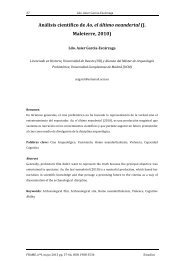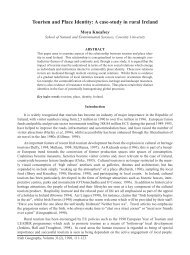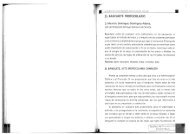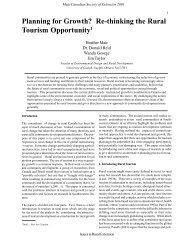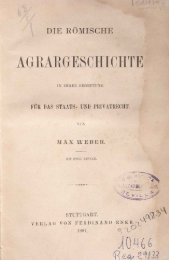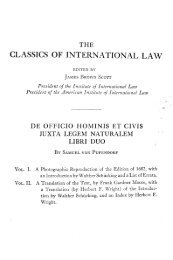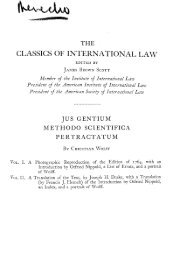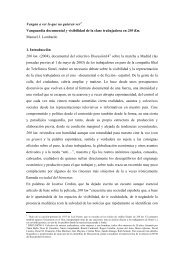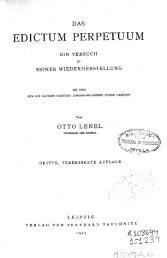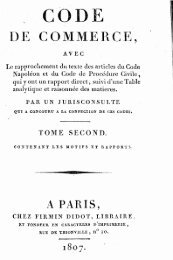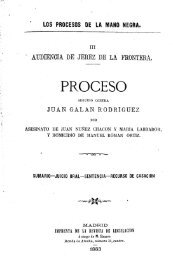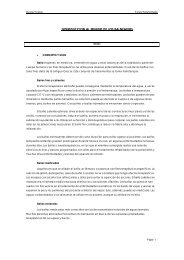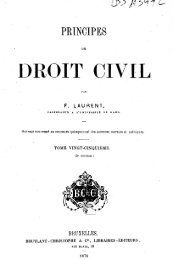Measuring Sustainable Tourism Development in Remote Rural ...
Measuring Sustainable Tourism Development in Remote Rural ...
Measuring Sustainable Tourism Development in Remote Rural ...
You also want an ePaper? Increase the reach of your titles
YUMPU automatically turns print PDFs into web optimized ePapers that Google loves.
<strong>Measur<strong>in</strong>g</strong> <strong>Susta<strong>in</strong>able</strong> <strong>Tourism</strong> <strong>Development</strong><br />
<strong>in</strong> <strong>Remote</strong> <strong>Rural</strong> Communities of Europe<br />
Carlos Oliveira Fernandes,<br />
Escola Superior de Tecnologia e Gestão<br />
do Instituto Politécnico de Viana do Castelo (Portugal)<br />
cfernandes@estg.ipvc.pt<br />
Charlotte R. Rass<strong>in</strong>g,<br />
Research Centre of Bornholm (Denmark)<br />
rass<strong>in</strong>g@rcb.dk<br />
6th World Leisure Congress, “Leisure and Human <strong>Development</strong>”, Research Thematic<br />
Area<br />
Assess<strong>in</strong>g the potential for tourism development <strong>in</strong> peripheral areas is complicated.<br />
Peripheral areas often possess characteristics that are demanded by tourists, and<br />
tourism is often seen as a panacea for such areas both nationally and locally. It is not<br />
simply a question of match<strong>in</strong>g what the tourists want with what communities can<br />
provide, but critically it depends <strong>in</strong> large measure upon local acceptability. It is often<br />
ma<strong>in</strong>ta<strong>in</strong>ed that the attitude of residents is important because residents themselves are<br />
potentially part of the tourists’ experiences if they <strong>in</strong>teract with local people (Ryan,<br />
Scotland and Montgomery, 1998).<br />
Akis, Peristianis and Warner (1996) argue that as the number of visitors to a region<br />
<strong>in</strong>creases, residents who at first were overwhelm<strong>in</strong>gly positive <strong>in</strong> their attitudes to their<br />
guests develop <strong>in</strong>creas<strong>in</strong>g reservations concern<strong>in</strong>g the long-term benefits of the<br />
visitors. This may be because the orig<strong>in</strong>al expectations of the benefits of tourism were<br />
unrealistic (and so are <strong>in</strong>capable of be<strong>in</strong>g fulfilled) or because the benefits are<br />
perceived to accrue only to a small number of people.<br />
This paper sets out to analyse cross-sectoral rural susta<strong>in</strong>ability <strong>in</strong>dicators <strong>in</strong> an open<br />
participatory bottom-up process that may enable peripheral rural areas to monitor the<br />
contribution of tourism to susta<strong>in</strong>able development objectives at local community level.<br />
It is <strong>in</strong>tended as supply related research, tak<strong>in</strong>g a stakeholder approach to the<br />
development process, empower<strong>in</strong>g communities to identify practical ways for achiev<strong>in</strong>g<br />
social and economic progress while protect<strong>in</strong>g the environment, conserv<strong>in</strong>g its valuable<br />
natural resources, and ensur<strong>in</strong>g its long term productivity and quality of life.<br />
It will take as case studies the communities of L<strong>in</strong>doso and Soajo, <strong>in</strong> mounta<strong>in</strong>ous<br />
northern Portugal, and the community of Svaneke, next to the coast <strong>in</strong> the island of<br />
Bornholm, Denmark. All three communities are characterised by low population<br />
density, depopulation, agriculturally based and little economic diversity. The survey<br />
research, carried out <strong>in</strong> August and September of 1999, at the study sites, was made<br />
possible by grants from the follow<strong>in</strong>g <strong>in</strong>stitutions: the Instituto de Cooperação Cientifica<br />
e Tecnológica Internacional (Portugal), <strong>in</strong> a protocol with the Danish Research<br />
Academy (Denmark). The project partners were the Polytechnic Institute of Viana do<br />
Castelo and the Research Centre of Bornholm
Introduction<br />
<strong>Tourism</strong> is seen as a possible and viable strategy for development <strong>in</strong> many remote<br />
rural areas, be<strong>in</strong>g viewed as perhaps best meet<strong>in</strong>g the requirements of environmental<br />
susta<strong>in</strong>ability, employment, public and private <strong>in</strong>vestment, <strong>in</strong>frastructure betterment and<br />
economic benefits. The development of tourist facilities and recreational opportunities<br />
has frequently been viewed as a means of redress<strong>in</strong>g regional disparities <strong>in</strong> <strong>in</strong>comes<br />
and employment (Mathieson and Wall, 1982). Tourists can play an important part of<br />
community development by giv<strong>in</strong>g local residents the possibility of earn<strong>in</strong>g some<br />
additional <strong>in</strong>come. It is argued that s<strong>in</strong>ce local materials and labour are employed <strong>in</strong><br />
local production, it represents potential for small-scale development of susta<strong>in</strong>able<br />
tourism.<br />
The economy of remote rural areas has traditionally been dependent upon a s<strong>in</strong>gle<br />
local <strong>in</strong>dustry, either agriculture, fisheries or other (but mostly agriculture). Thus<br />
agriculture will, <strong>in</strong>evitably, have an <strong>in</strong>fluence on local tourism development, s<strong>in</strong>ce it is<br />
still part of the local people’s daily lives. Cox and Fox (1991) illustrated the important<br />
relationship between agriculture and tourism, recognis<strong>in</strong>g the need to exam<strong>in</strong>e this<br />
further, to ensure that the potential of agriculturally based leisure attractions could be<br />
realised. “Agriculture is traditionally the economic ma<strong>in</strong>stay of rural areas, there is a<br />
l<strong>in</strong>kage between agriculture and tourism”.<br />
The current global tourism market is experienc<strong>in</strong>g changes <strong>in</strong> tourism demand and<br />
consumption patterns as perhaps never before. The tourism consumer is chang<strong>in</strong>g<br />
through greater awareness of the world, wider experiences and tourism products, both<br />
domestically and <strong>in</strong>ternationally, and through chang<strong>in</strong>g consumer pressures and<br />
expectations. The current affects of change are lead<strong>in</strong>g to the rise <strong>in</strong> the<br />
“unmanageable” consumer, the consumer who is more knowledgeable with a wider<br />
perspective of tourism and its products and therefore <strong>in</strong>creas<strong>in</strong>gly demand<strong>in</strong>g (Jones,<br />
1997). This may imply that <strong>in</strong>ternational mass tourism is no longer a homogenous<br />
phenomenon it purportedly used to be.<br />
Chang<strong>in</strong>g perceptions are lead<strong>in</strong>g to higher expectations or desired services by<br />
consumers <strong>in</strong> tourist areas. However, not only is it desirable to study the nature of<br />
tourist demand and the character of the accompany<strong>in</strong>g movements of people, for the<br />
purpose of understand<strong>in</strong>g the driv<strong>in</strong>g forces beh<strong>in</strong>d recent growth <strong>in</strong> tourism: it is also<br />
desirable to know someth<strong>in</strong>g about the impact (environmental, economic, cultural etc.)<br />
of the tourists on the areas which they visit. The need for studies <strong>in</strong> this field has<br />
grown with the realisation that tourist developments do not always br<strong>in</strong>g benefit to the<br />
host areas; <strong>in</strong>deed they may lead to the accentuation of the exist<strong>in</strong>g social and<br />
economic problems or to the creation of new problems altogether (White, 1974: 1-2)<br />
Literature Review<br />
The susta<strong>in</strong>able approach to development is not new and there have been many<br />
<strong>in</strong>terpretations of what susta<strong>in</strong>able development is. But it is now generally accepted<br />
that susta<strong>in</strong>able development recognises the validity of three <strong>in</strong>terests - the<br />
environment (natural and man made), the economy and socio-cultural concerns<br />
(Macgillivray & Zadek, 1995). Writers generally trace the orig<strong>in</strong>s of the term<br />
"susta<strong>in</strong>able development" back to a 1987 World Commission on Environment and<br />
<strong>Development</strong> report entitled "Our Common Future", also known as the Brundtland
Report. This commission, established by the United Nations General Assembly <strong>in</strong><br />
1984, was asked to learn about the connections between the issues of environment<br />
and development. Hence, the term was first used to br<strong>in</strong>g together the apparently<br />
disparate concepts of economic development and environmental conservation. The<br />
Brundtland Report def<strong>in</strong>ed susta<strong>in</strong>able development as:<br />
“<strong>Development</strong> that meets the needs of the present generation without<br />
compromis<strong>in</strong>g the ability of future generations to meet their own needs (p.<br />
43)”<br />
Real community development must <strong>in</strong>clude physical development with people<br />
development; economic development with political development; <strong>in</strong>creas<strong>in</strong>g a<br />
community’s capacity for tak<strong>in</strong>g control of its own development. For this to occur, each<br />
at its own pace, an evolv<strong>in</strong>g process is necessary for build<strong>in</strong>g with<strong>in</strong> the community the<br />
ability for critical th<strong>in</strong>k<strong>in</strong>g and plann<strong>in</strong>g with an <strong>in</strong>creased capacity to meet future needs.<br />
Experience has provided some clear lessons about what works and what does not<br />
work <strong>in</strong> community- based development. Prom<strong>in</strong>ent among the failures has been<br />
attempts to achieve results on a wide scale through the <strong>in</strong>fusion of external<br />
management, funds, and technology, controlled from distant places.<br />
A fundamental prerequisite of successful participatory programs at the community level<br />
is the reversal of control and accountability from central authorities to the community<br />
level; and, when the success of projects depends heavily on changes <strong>in</strong> behaviour at<br />
the community level, promot<strong>in</strong>g participation <strong>in</strong> community-based programs may be the<br />
only means of meet<strong>in</strong>g objectives (World Bank, 1998). It is up to <strong>in</strong>dividual<br />
communities to determ<strong>in</strong>e how they want to balance the status quo with the benefits of<br />
growth, and how effective they are go<strong>in</strong>g to be <strong>in</strong> mitigat<strong>in</strong>g the negative effects they<br />
want to avoid. In order to achieve these ends, new techniques to supplement and <strong>in</strong><br />
some cases replace the traditional methods of land use control are required (Scott,<br />
Brower and M<strong>in</strong>er, 1975).<br />
It is suggested that the plann<strong>in</strong>g process needs to <strong>in</strong>volve those people who live, work,<br />
own property, or own bus<strong>in</strong>esses <strong>in</strong> the community and <strong>in</strong>cludes the organisations and<br />
<strong>in</strong>stitutions <strong>in</strong> the plann<strong>in</strong>g process. This bottom-up approach empowers communities<br />
through local actors, i.e. people’s organisations, for creat<strong>in</strong>g important sources of<br />
action at the local level with a strong <strong>in</strong>terest for promot<strong>in</strong>g susta<strong>in</strong>able livelihood. In<br />
other words, it needs to <strong>in</strong>clude the local residents and the local stakeholders work<strong>in</strong>g<br />
together to promote mutual responsibility and jo<strong>in</strong>t problem solv<strong>in</strong>g.<br />
In establish<strong>in</strong>g and promot<strong>in</strong>g grass-roots mechanisms, capacity-build<strong>in</strong>g and<br />
empowerment, we are <strong>in</strong>duc<strong>in</strong>g a community-driven approach to susta<strong>in</strong>able<br />
development. In this context it is critical to view community economic development as a<br />
long-term process that fuses community control and direction with specific tools and<br />
outcomes (Zdenek, 1987). Empowerment does not so much mean grant<strong>in</strong>g or<br />
transferr<strong>in</strong>g power as it does <strong>in</strong>creas<strong>in</strong>g civic awareness of the efficacy of democratic<br />
<strong>in</strong>volvement, through self-respect, mutual esteem, capacity-build<strong>in</strong>g, genu<strong>in</strong>e<br />
responsiveness and open accountability (Schwer<strong>in</strong>, 1995). The diverse members of<br />
the community should be represented <strong>in</strong> order to, more appropriately, identify the<br />
community´s strengths and assets, needs and concerns; establish goals for<br />
community development; provide recommendations for how to reach those goals; and,<br />
<strong>in</strong>fluence, or possibly direct, the policy and f<strong>in</strong>ancial decisions of local decision-makers.
Unfortunately, <strong>in</strong> remote areas, many, if not most, local public officials and community<br />
leaders are part time and/or volunteers with limited experience or knowledge of<br />
recently enacted economic development or growth management practices. The lack of<br />
experience and time to become acqua<strong>in</strong>ted with such practices often means that<br />
relatively little community development plann<strong>in</strong>g occurs (Walzer and Deller, 1996: 9-<br />
10). This factor may lead to little plann<strong>in</strong>g and development, or just pla<strong>in</strong> bad plann<strong>in</strong>g.<br />
The peripheral location of many rural areas and their poor external communications<br />
make them relatively unattractive to many employers and firms outside these areas<br />
(Shaw, 1979). Local development efforts cont<strong>in</strong>ue to help rural communities assess<br />
tourism as a potential economic development strategy. The basic question should be<br />
how to develop tourism appropriate to the needs of each locality or region (Bramwell et<br />
al, 1996). How can local <strong>in</strong>terests and needs be satisfied by the <strong>in</strong>crease of <strong>in</strong>creased<br />
tourism <strong>in</strong> the community? Assess<strong>in</strong>g the potential for tourism development <strong>in</strong><br />
peripheral areas is complicated. It is not simply a question of match<strong>in</strong>g what the<br />
tourists want with what communities can provide, but critically it depends <strong>in</strong> large<br />
measure upon local acceptability. The complex social problems <strong>in</strong> rural areas make it<br />
necessary for development to <strong>in</strong>volve measures that improve, above all, the human<br />
condition and the quality of life of its residents, guided by the pr<strong>in</strong>ciples of equity and<br />
justice.<br />
The core issue for understand<strong>in</strong>g the community-tourism relationship centres on how<br />
community members communicate and <strong>in</strong>teract, how they are <strong>in</strong>fluenced <strong>in</strong> their<br />
op<strong>in</strong>ions and how this dynamic process of <strong>in</strong>fluence might be successfully managed for<br />
susta<strong>in</strong>able tourism enterprises (Pearce et al, 1996: 228). The failure of local officials<br />
and residents to comprehend both the positive and negative impacts of tourism to the<br />
local economy and community severely <strong>in</strong>hibits progress (Long, 1991; McLaugl<strong>in</strong> et al,<br />
1991; and Murphy, 1985). As the number of visitors to a region <strong>in</strong>creases, residents<br />
who at first were overwhelm<strong>in</strong>gly positive <strong>in</strong> their attitudes to their guests develop<br />
<strong>in</strong>creas<strong>in</strong>g reservations concern<strong>in</strong>g the long-term benefits of the visitors. This may be<br />
because the orig<strong>in</strong>al expectations of the benefits of tourism were unrealistic (and so are<br />
<strong>in</strong>capable of be<strong>in</strong>g fulfilled) or because the benefits are perceived to accrue only to a<br />
small number of people.<br />
Alternatively, although expectations of the benefits are realised, the environmental or<br />
social costs were <strong>in</strong>itially overlooked, or excessively discounted, so that the local<br />
residents come to doubt whether their visitors are an unqualified bless<strong>in</strong>g (Akis,<br />
Peristianis and Warner, 1996: 481). Pizam (1978) has attempted to determ<strong>in</strong>e<br />
empirically the existence of negative impacts of tourism with the hypothesis that heavy<br />
tourism concentration on a dest<strong>in</strong>ation area leads to negative resident attitudes toward<br />
tourists and tourism <strong>in</strong> general. His study seems to confirm the hypothesised<br />
relationship between an <strong>in</strong>dividual’s economic dependency on tourism and one’s<br />
overall attitude towards tourism. It was found that the more dependent a person was<br />
on tourism as a means of livelihood, the more positive was that person’s overall<br />
attitude toward tourism <strong>in</strong> the study area. People are cont<strong>in</strong>ually assess<strong>in</strong>g their<br />
situation and surround<strong>in</strong>gs. For effective community-based <strong>in</strong>dicators we need to<br />
translate the th<strong>in</strong>gs people want to measure <strong>in</strong>to a manageable form. The purpose of<br />
measurement is to make values more precise, to compare and evaluate one th<strong>in</strong>g<br />
aga<strong>in</strong>st another (Lee-Smith, 1997)
Methodology<br />
The ma<strong>in</strong> purpose of attitude research is to exam<strong>in</strong>e the association between particular<br />
attitudes and a number of other variables. The study sites were selected because their<br />
ly<strong>in</strong>g characteristics are similar <strong>in</strong> terms of livelihood strategies, because of the similar<br />
geographical (remote) and agricultural conditions they experience, and because the<br />
village of Svaneke has a lot of tourism, Soajo has some tourism, and L<strong>in</strong>doso has<br />
mostly day visitors. The tourism <strong>in</strong> Svaneke is based on people from the rest of<br />
Denmark, Germany and Sweden while tourism <strong>in</strong> both Soajo and L<strong>in</strong>doso mostly is<br />
based on domestic tourism. These factors together offered the opportunity to make<br />
comparative study between areas with tourism and areas with little or none.<br />
A field survey, carried out dur<strong>in</strong>g the months of August and September of 1999,<br />
consisted of two phases: a week-long survey to ga<strong>in</strong> an overview of the region and to<br />
select communities for further study, and a another week-long survey to ga<strong>in</strong><br />
knowledge <strong>in</strong>to local residents’ perceptions of local tourism. One community was<br />
selected <strong>in</strong> Denmark and two <strong>in</strong> Portugal. The questionnaire was adm<strong>in</strong>istered to a<br />
random sample of households. The questionnaire was completed by <strong>in</strong>terview with<br />
each member of the household over 16 years of age, up to a maximum of three per<br />
household. No attempt was made to either encourage or discourage multiple returns<br />
from a household, but respondents were asked to fill out the questionnaire<br />
<strong>in</strong>dependently. It was expla<strong>in</strong>ed that the survey was to assess tourism <strong>in</strong> the area. It<br />
was also stressed that the survey was not a test and that there were no right or wrong<br />
answers. Overall, there were 30 samples <strong>in</strong> each L<strong>in</strong>doso and Soajo and 29 <strong>in</strong><br />
Svaneke.<br />
The community attitude questionnaire comprised four sections. The first section of the<br />
questionnaire consisted of attitud<strong>in</strong>al statements concern<strong>in</strong>g the level of solidarity <strong>in</strong> the<br />
community and to establish a community profile. The second consisted of 33<br />
attitud<strong>in</strong>al statements concern<strong>in</strong>g respondents’ frequency of <strong>in</strong>teraction with tourists<br />
and their <strong>in</strong>volvement with the tourism <strong>in</strong>dustry and about the residents’ general op<strong>in</strong>ion<br />
about tourism <strong>in</strong> the community. The third section looked at the specific concerns<br />
about tourism and possible advantages and disadvantages of economic, social and<br />
environmental impacts of tourism and their relationship to tourism development. A f<strong>in</strong>al<br />
section elicited <strong>in</strong>formation on which should be the specific goals for tourism and<br />
whether or not tourism has effected the local employment situation.<br />
Discussion and f<strong>in</strong>d<strong>in</strong>gs<br />
The level of meet<strong>in</strong>g attendance is almost the same <strong>in</strong> L<strong>in</strong>doso/Soajo and <strong>in</strong> Svaneke.<br />
However, more residents serve on a committee work<strong>in</strong>g to improve the quality of life<br />
and more residents speak to the town council about community problems <strong>in</strong><br />
L<strong>in</strong>doso/Soajo that <strong>in</strong> Svaneke (see table 1). This could very well reflect the different<br />
standards of liv<strong>in</strong>g <strong>in</strong> the compared communities (see also statement 3 <strong>in</strong> table 1). The<br />
standard of liv<strong>in</strong>g <strong>in</strong> Svaneke is relatively high and therefore <strong>in</strong>habitants do not need an<br />
improvement. Maybe residents <strong>in</strong> L<strong>in</strong>doso/Soajo participate more because they are<br />
less happy with their liv<strong>in</strong>g conditions and quality of life. Residents <strong>in</strong> L<strong>in</strong>doso/Soajo<br />
might have the feel<strong>in</strong>g that some th<strong>in</strong>gs should change; that there might be more<br />
difficulties <strong>in</strong> the two jo<strong>in</strong><strong>in</strong>g communities.
Table 1: Community participation<br />
Item<br />
L<strong>in</strong>doso/Soajo<br />
Yes No<br />
Svaneke<br />
Yes No<br />
Did you attend any of the last three meet<strong>in</strong>gs of the<br />
local council?<br />
24% 76% 20% 80%<br />
Do you serve on any committee work<strong>in</strong>g to improve<br />
the quality of life?<br />
48% 52% 32% 68%<br />
Do you persuade others to take a particular position? 66% 34% 24% 76%<br />
Do you speak to the town council about community<br />
problems?<br />
71% 29% 52% 48%<br />
When it comes to persuad<strong>in</strong>g others to take a particular position the distribution <strong>in</strong><br />
Soajo/L<strong>in</strong>doso and Svaneke is significant different. The reason for this could be that <strong>in</strong><br />
Svaneke, as <strong>in</strong> Denmark <strong>in</strong> general, you do not want to <strong>in</strong>terfere with your neighbours –<br />
they are allowed to th<strong>in</strong>k and believe what they wish and you should not discuss<br />
disagreements. The situation <strong>in</strong> Soajo/L<strong>in</strong>doso is different, mostly as a result of the<br />
need for contact with neighbours due to the daily agricultural tasks.<br />
Table 2, below shows the average scores for 27 different statement regard<strong>in</strong>g the<br />
community profile. In general the citizens <strong>in</strong> Svaneke seem to be much more satisfied<br />
than the citizens <strong>in</strong> Soajo/L<strong>in</strong>doso. The answer that differs most significantly is car<strong>in</strong>g of<br />
the community’s look. Svaneke has a reputation for be<strong>in</strong>g one of the most beautiful<br />
towns <strong>in</strong> Denmark. The <strong>in</strong>habitants are very proud of their town and wish to ma<strong>in</strong>ta<strong>in</strong> it.<br />
In Soajo/L<strong>in</strong>doso the cultural architecture has suffered some damage as local people<br />
are push<strong>in</strong>g for what has been termed “rural urbanisation”. Another statement worth<br />
mention<strong>in</strong>g is statement 4. The answers to this question aga<strong>in</strong> reflect the cultural<br />
differences between the communities. In Denmark the public sector is almost obliged<br />
to take care of the eldest people and you would never expect it to be a family-matter.<br />
Until a few years ago, <strong>in</strong> Soajo/L<strong>in</strong>doso k<strong>in</strong>ship ties were still strong and it was still<br />
seen as the responsibility of each family to care for their own. Accord<strong>in</strong>g to statement<br />
3 <strong>in</strong> table 2, one may conclude that it is now a generally accepted fact that the public<br />
sector has to care for the elderly. The exodus of the young <strong>in</strong> the last 40-50 years<br />
probably has been the most <strong>in</strong>fluential factor this change. Today, these people live <strong>in</strong><br />
other countries; their parents or those who chose not to emigrate are now older and<br />
with few relatives to look after them.<br />
The attitudes towards some of the statements are very much alike <strong>in</strong> the two different<br />
areas observed. Statement 27 stand out, because of the assertion made by the<br />
respondents that, apparently, “what is good for the community is good for me”. It is also<br />
generally agreed by the residents of the two study areas that few people should be<br />
<strong>in</strong>volved <strong>in</strong> community plann<strong>in</strong>g and improvement and that only those with the most<br />
time should have the responsibility for civic activities. Here, most time implies “free<br />
time”, or time <strong>in</strong> which people are not actively work<strong>in</strong>g. So, for example <strong>in</strong><br />
Soajo/L<strong>in</strong>doso, a farmer who has much land and spends all day work<strong>in</strong>g that land<br />
should benefit from recreational activities organised by those who have less land, thus<br />
more disposable time. The researchers observed that the people most seen at local<br />
cafés were precisely the people who had less land and no other source of employment.
Tabel 2: Average scores for the 27 community profile items<br />
Statement L<strong>in</strong>doso/ Svaneke Numerical<br />
Soajo<br />
difference<br />
1 None seems to care much how the community looks. 3.73 1.96 1.77<br />
2 Everyone here tries to take advantage of you. 3.21 1.52 1.69<br />
3 Liv<strong>in</strong>g conditions <strong>in</strong> the community should be improved 4.63 3.00 1.63<br />
4 The responsibility for older people should be conf<strong>in</strong>ed to themselves and<br />
their families <strong>in</strong>stead of the community.<br />
3.10 1.60 1.50<br />
5 Our schools do a poor job of prepar<strong>in</strong>g young people for life. 3.76 2.28 1.48<br />
6 A community would get along better if each one would m<strong>in</strong>d his own<br />
bus<strong>in</strong>ess and others take care of theirs.<br />
2.83 1.83 1.00<br />
7 People are generally critical of others. 4.23 3.24 0.99<br />
8 A good citizen should be will<strong>in</strong>g to assume leadership <strong>in</strong> a civic<br />
improvement organisation.<br />
3.98 3.00 0.98<br />
9 The town council gets very little done. 3.91 3.04 0.87<br />
10 The community tries hard to help its young people along. 2.09 2.93 0.84<br />
11 If their children keep out of their way, parents are satisfied to let them do 2.77 2.00 0.77<br />
what they want to do<br />
12 Everyone is out for himself at the expense of everyone else 2.98 2.28 0.70<br />
13 People do not work together to get th<strong>in</strong>gs done for the community. 3.62 2.93 0.69<br />
14 The church is a constructive factor for better community life. 3.27 2.69 0.58<br />
15 This community lacks real leaders. 4.02 3.41 0.51<br />
16 The local council runs the town to suit themselves. 3.27 2.78 0.49<br />
17 Progress can best be accomplished by hav<strong>in</strong>g only a few people <strong>in</strong>volved. 2.92 2.45 0.47<br />
18 People give you a bad name if you <strong>in</strong>sist on be<strong>in</strong>g different. 3.63 3.29 0.34<br />
19 A citizen should jo<strong>in</strong> only those organisations that will promote his own<br />
<strong>in</strong>terests.<br />
1.97 2.27 0.30<br />
20 Busy people should not have the responsibility for civic programmes. 3.52 3.32 0.20<br />
21 Most of the churchgoers do not practice what they preach. 4.02 3.82 0.20<br />
22 Only those who have the most time should assume the responsibility for<br />
civic programmes.<br />
3.05 3.24 0.19<br />
23 Too much time is usually spent on the plann<strong>in</strong>g phases of community<br />
projects.<br />
3.78 3.60 0.18<br />
24 Community improvement should be the concern of only a few leaders <strong>in</strong><br />
the community.<br />
1.93 1.89 0.04<br />
25 What is good for the community is good for me. 3.83 3.80 0.03<br />
26 In order to grow, a community must provide additional recreation facilities. 4.08 4.11 0.03<br />
27 The social needs of the citizens are the responsibility of themselves and<br />
their families and not of the community.<br />
2.20 2.19 0.01<br />
(strongly agree=5; strongly disagree=1)<br />
The residents of both L<strong>in</strong>doso/Soajo and Svaneke are found to have a positive attitude<br />
to tourism, ma<strong>in</strong>ly because of the employment opportunities it offers, even if they<br />
themselves do not ga<strong>in</strong> any direct benefit from this sector (see tables 3 and 4). In the<br />
case of Soajo, most residents of the community are aware of the concentration of<br />
tourists around one s<strong>in</strong>gle village that is felt to have unfairly captured the local tourism<br />
market by hav<strong>in</strong>g most <strong>in</strong>vestment concentrated on that one village. The other villages<br />
of Soajo, hav<strong>in</strong>g little or no tourism benefits, feel that they have attractions that could<br />
draw people. But because of a lack of <strong>in</strong>terest on the part of the local leadership, it has<br />
not been local policy to distribute <strong>in</strong>frastructure <strong>in</strong>vestment <strong>in</strong> the other villages. The<br />
researchers feel that the ma<strong>in</strong> reason is a lack of leadership and entrepreneurship<br />
among the smaller villages. Also, hav<strong>in</strong>g to do with the traditional patriarchal system all<br />
major activities are conducted around the village where the ma<strong>in</strong> church is located.<br />
Because the local elite is traditionally from this village, and because these elite carry a<br />
high <strong>in</strong>fluence <strong>in</strong> the community, the residents of the ma<strong>in</strong> village tend to be more<br />
dynamic and entrepreneurial. Thus, local <strong>in</strong>vestment, be it public or private, tends to be<br />
concentrated.<br />
Svaneke is a tourist-town from May – September. The town is well-known by the<br />
visitors to Bornholm and almost everyone wishes to go there once dur<strong>in</strong>g their holiday.
Therefore it is very crowded <strong>in</strong> the ma<strong>in</strong> season. Apparently these many visitors are bid<br />
welcome by the residents and more than one third of the residents depend on them.<br />
Table 3: Effect of tourism on own job/How tourism affects <strong>in</strong>dividuals<br />
Effect L<strong>in</strong>doso/ Soajo Svaneke<br />
Very negatively impacted 5% 0<br />
Somewhat negatively impacted 0 12%<br />
Not affected 70% 41%<br />
Somewhat dependent 12% 12%<br />
Very dependent 14% 35%<br />
Table 4: Specific goals for tourism (%)<br />
L<strong>in</strong>doso/Soajo Svaneke<br />
1 2 3 1 2 3<br />
Employment opportunities 77 11 5 70 9 0<br />
More or better parks and recreational facilities 7 21 13 0 13 0<br />
A more vital and active local economy 4 23 9 4 26 26<br />
Social or cultural <strong>in</strong>teraction with people from other states 7 16 29 15 13 21<br />
and countries<br />
The overall quality of life <strong>in</strong> the community 4 14 23 0 17 26<br />
The overall appearance of the community 0 5 9 7 9 21<br />
An <strong>in</strong>crease <strong>in</strong> the value of real estate 2 7 13 0 13 5<br />
Other 0 2 0 4<br />
1= Biggest Advantage 2=Next Biggest Advantage 3=Third Biggest Advantage<br />
The residents <strong>in</strong> L<strong>in</strong>doso/Soajo and the residents <strong>in</strong> Svaneke see employment<br />
opportunities as the biggest advantage of tourism (see table 5). In L<strong>in</strong>doso/Soajo<br />
some of the residents expressed the op<strong>in</strong>ion that the <strong>in</strong>creas<strong>in</strong>g revenue from tourism<br />
was extremely fortunate <strong>in</strong> that it complemented local agriculture. More or better parks<br />
and recreational facilities and a more vital and active local economy are the next<br />
biggest advantages accord<strong>in</strong>g to residents <strong>in</strong> L<strong>in</strong>doso/Soajo together with social and<br />
cultural <strong>in</strong>teraction with people from other states and communities.<br />
The residents <strong>in</strong> L<strong>in</strong>doso/Soajo as well as the residents <strong>in</strong> Svaneke see traffic<br />
congestion as the biggest disadvantage of the development of tourism. The traffic<br />
congestion bothers more people <strong>in</strong> Svaneke than <strong>in</strong> L<strong>in</strong>doso/Soajo. Crowded<br />
recreation areas and facilities and higher prices for goods and services are <strong>in</strong><br />
L<strong>in</strong>doso/Soajo also seen as big disadvantages of tourism (see table 5).<br />
Table 5: Specific concerns about tourism <strong>in</strong> the Community (%)<br />
L<strong>in</strong>doso/Soajo Svaneke<br />
1 2 3 1 2 3<br />
Traffic congestion 29 20 14 52 9 15<br />
Crowded recreation areas and facilities 26 19 2 8 9 15<br />
Higher prices for goods and services 20 19 18 12 30 15<br />
More crime 4 4 10 4 13 5<br />
Higher taxes 2 11 8 4 4 10<br />
Environmental impacts 6 15 18 8 13 15<br />
Overdevelopment 0 2 6 4 0 0<br />
An <strong>in</strong>crease <strong>in</strong> the cost of real estate 9 4 6 4 9 10<br />
Too many out-of-the-community hunters/fishermen 0 4 10 0 0 0<br />
Too many out-of-the-community people relocat<strong>in</strong>g to the 2 4 10 0 9 15<br />
area<br />
Look <strong>in</strong>to private homes through the w<strong>in</strong>dows 4<br />
Too much garbage 4 4<br />
1= Biggest Disadvantage 2=Next Biggest Disadvantage 3=Third Biggest Disadvantage
Residents <strong>in</strong> L<strong>in</strong>doso/Soajo are very positive when it comes to the impact of tourist and<br />
the level while the citizens <strong>in</strong> Svaneke are not as positive towards tourism as it appeals<br />
above. Residents <strong>in</strong> L<strong>in</strong>doso/Soajo do not th<strong>in</strong>k that tourism will have a negative impact<br />
on <strong>in</strong>cidence of crime, will not have a negative impact on recreation areas, is not a<br />
burden for community services and does not have a negative impact on the<br />
environment. They th<strong>in</strong>k that tourism will encourage <strong>in</strong>vestment <strong>in</strong> their community and<br />
will provide jobs for the local people. Accord<strong>in</strong>g to the residents of L<strong>in</strong>doso/Soajo,<br />
should the region attract more visitors to the area, they would like to be <strong>in</strong>volved <strong>in</strong><br />
decisions about further tourism development.<br />
Most of the statements <strong>in</strong> table 6 show that even though residents <strong>in</strong> Svaneke are to<br />
some extent positive towards tourism (statements 22 and 23 ) they still believe that the<br />
tourists are a burden on the community services, that the tourists have <strong>in</strong>creased the<br />
crime problems, that tourism has negatively impact on the environment, that the region<br />
should not try to attract more tourists and they are not that conv<strong>in</strong>ced that tourism<br />
encourages <strong>in</strong>vestment <strong>in</strong> the local economy.<br />
Table 6: Average scores for the 33 items on residents op<strong>in</strong>ion about tourism <strong>in</strong> the Community<br />
Statement<br />
L<strong>in</strong>doso/<br />
Soajo<br />
Svaneke Numerical<br />
Difference<br />
1 Tourists are a burden on the Community services. 1.88 4.07 2.19<br />
2 <strong>Tourism</strong> encourages <strong>in</strong>vestment <strong>in</strong> our local economy. 4.00 1.93 2.07<br />
3 <strong>Tourism</strong> development <strong>in</strong> my community will provide jobs for local people. 4.17 2.17 2.00<br />
4 It is important that Community residents be <strong>in</strong>volved <strong>in</strong> decisions about tourism. 4.17 2.24 1.93<br />
5 Tourists crowd out local residents <strong>in</strong> good recreation areas. 2.92 4.14 1.92<br />
6 Communities of this region should not try to attract more visitors. 1.90 3.82 1.92<br />
7 <strong>Tourism</strong> has <strong>in</strong>creased the number of crime problems <strong>in</strong> the Community. 1.98 3.79 1.81<br />
8 <strong>Tourism</strong> has negatively impacted the environment. 2.47 4.18 1.81<br />
9 The tourism <strong>in</strong>dustry provides many worthwhile employment opportunities for 3.20 1.72 1.48<br />
Community residents.<br />
10 More outdoor recreation development is not desirable. 2.10 3.57 1.47<br />
11 The Community should take steps to restrict tourism development. 2.68 4.14 1.46<br />
12 In the shops and restaurants, tourists are preferred compared to local people. 2.85 4.22 1.37<br />
13 The Community is becom<strong>in</strong>g overcrowded because of more tourists. 2.18 3.48 1.30<br />
14 I believe tourism should be actively encouraged <strong>in</strong> my community. 4.43 3.22 1.21<br />
15 Decisions about how much tourism we should have <strong>in</strong> the Community are best 2.72 3.71 0.99<br />
left to the private sector.<br />
16 Tourists do not pay their fair share for the services they use. 2.68 3.63 0.95<br />
17 The overall benefits of tourism outweigh the negative impacts 3.38 2.45 0.93<br />
18 <strong>Tourism</strong> is responsible for too fast a rate of development <strong>in</strong> the Community. 2.48 3.39 0.91<br />
19 By the way of ris<strong>in</strong>g tourism there are more cultural events. 3.44 2.62 0.82<br />
20 The most important factor <strong>in</strong> determ<strong>in</strong><strong>in</strong>g how much tourism to have <strong>in</strong> the<br />
Community is the impact on local quality of life.<br />
3.66 2.89 0.77<br />
21 The number of jobs produced by tourism is the best measure of success for the<br />
Community.<br />
3.83 3.19 0.64<br />
22 The Quality of public services has improved due to tourism <strong>in</strong> my community. 3.09 3.67 0.58<br />
23 The community should encourage more <strong>in</strong>tensive development of tourist 4.21 3.64 0.57<br />
facilities.<br />
24 Shopp<strong>in</strong>g opportunities are better <strong>in</strong> my community as a result of tourism 3.26 2.76 0.50<br />
25 My community should become more of a tourist dest<strong>in</strong>ation 4.12 3.68 0.42<br />
26 S<strong>in</strong>ce tourists have arrived I have more recreational opportunities available. 2.95 3.37 0.42<br />
27 The benefits of tourism outweigh the negative consequences of tourism<br />
development.<br />
2.97 2.71 0.26<br />
28 Our household standard of liv<strong>in</strong>g is higher because of money tourists spend 2.68 2.89 0.21<br />
here.<br />
29 I would prefer that tourists visit our area but not move here. 2.98 3.17 0.19<br />
30 The Quality of life <strong>in</strong> the Community has improved because of tourism. 3.38 3.46 0.08<br />
31 Most of the jobs <strong>in</strong> the tourism <strong>in</strong>dustry are low paid. 3.72 3.66 0.06<br />
32 The jobs tourism provides are highly desirable jobs. 3.63 3.67 0.04<br />
33 The environmental impacts result<strong>in</strong>g from tourism are relatively m<strong>in</strong>or. 3.00 3.03 0.03<br />
(strongly agree=5; strongly disagree=1)
Both the residents <strong>in</strong> L<strong>in</strong>doso/Soajo and Svaneke belives that the life <strong>in</strong> the community<br />
has improved because of tourism (statement 30).<br />
It seems that, accord<strong>in</strong>g to the residents, there exists hope for more tourism and<br />
development <strong>in</strong> tourism among the residents <strong>in</strong> L<strong>in</strong>doso/Soajo (statement 11, 14 and<br />
25 <strong>in</strong> table 6) while Svaneke has reached an upper level for the number of tourists<br />
(statement 13). L<strong>in</strong>doso/Soajo do not feel the negative impact nearly as much as<br />
Svaneke. The residents <strong>in</strong> Soajo/L<strong>in</strong>doso wish to spend resources to develop the<br />
community towards more tourism (statement 10 and 23).<br />
Accord<strong>in</strong>g to the socio-demographic characteristics (see table 7a-7f), the respondents<br />
<strong>in</strong> L<strong>in</strong>doso/Soajo have, basically, elementary and secondary education (80%), with<br />
21% of the respondents hav<strong>in</strong>g a higher level of education. In Svaneke 66% of the<br />
respondents have more than elementary and secondary education. The residents <strong>in</strong><br />
Svaneke are more academically educated. In terms of professions, there were major<br />
differences. The number of retired people stood out <strong>in</strong> Svaneke with 41% compared to<br />
L<strong>in</strong>doso/Soajo with 15%. This is reflected <strong>in</strong> the average age (see Table 7c). Also, <strong>in</strong><br />
L<strong>in</strong>doso/Soajo, 22% of the respondents were students, compared to no student<br />
respondents <strong>in</strong> Svaneke. The majority of the people <strong>in</strong>terviewed <strong>in</strong> L<strong>in</strong>doso/Soajo are<br />
men while the distribution <strong>in</strong> Svaneke is almost half-and-half.<br />
Table 7: Socio-demographic characteristics<br />
Table 7a: Occupation<br />
L<strong>in</strong>doso/Soajo Svaneke<br />
Occupation Assist<strong>in</strong>g spouses 17%<br />
Self-employed persons 0 15%<br />
Professional/management 2% 4%<br />
Adm<strong>in</strong>istrative 15% 26%<br />
Skilled 12%<br />
Unskilled wage earners 10% 11%<br />
Unemployed 7% 4%<br />
Retired 15% 41%<br />
Student 22%<br />
Table 7b: Education<br />
Education Elementary 51% 31%<br />
Secondary 29% 4%<br />
Vocational school 12% 42%<br />
Some college 2% 4%<br />
College graduate 7% 8%<br />
Post-graduate study 12%<br />
Table 7c: Age<br />
Average Age 40.91 56.29<br />
Table 7d: Gender<br />
Gender Male 71% 46%<br />
Female 29% 54%<br />
Table 7e: Average number of years lived <strong>in</strong> village<br />
Average number of years lived <strong>in</strong> village 29.35 23.85<br />
Table 7f:Lived outside the village more than one year<br />
Lived outside village more than 1 year Yes 57% 85%<br />
No 43% 15%<br />
If yes, how many years? Average 16.72 32.59
In L<strong>in</strong>doso/Soajo some 57% have been outside the area for more than one year. This<br />
is mostly due to the fact that this region has traditionally been one of the largest<br />
exporter of reserve labour to <strong>in</strong>dustrialised European countries. Studies have shown<br />
that these communities when confronted with little if any opportunities for employment<br />
that, <strong>in</strong>stead of allow<strong>in</strong>g fear and panic to tear the villages apart, or, on the other<br />
extreme, br<strong>in</strong>g<strong>in</strong>g the village together as a community, the young people were raised to<br />
f<strong>in</strong>d solutions to their economic problems not through political pressur<strong>in</strong>g and collective<br />
action but through <strong>in</strong>dividual <strong>in</strong>itiative and emigration (Graham, 1979).<br />
Table 7f shows that the majority (85%) of the residents <strong>in</strong> Svaneke has lived outside<br />
the area for more than one year. This is closely related to the level of education <strong>in</strong> the<br />
village. It you wish to be educated above secondary school you have to go to school <strong>in</strong><br />
the other end of the island and if you wish to graduate you need to move from the<br />
island.<br />
Conclusion<br />
As relevant literature has suggested, many are the communities <strong>in</strong> remote areas that<br />
have compromised the needs of the resident community to achieve tourism<br />
development goals. While <strong>in</strong> the short term such compromises at the expense of local<br />
<strong>in</strong>terests may seem appropriate courses of action, there may be negative<br />
repercussions at a later date (Gill and Williams, 1994: 218). The effect of these<br />
changes is the decl<strong>in</strong>e and erosion of traditional communities and life styles and an<br />
alteration of the whole economic and social system <strong>in</strong> the rural areas. Communities<br />
are no longer cohesive entities, and this <strong>in</strong> turn has an effect on both the viability of and<br />
participation <strong>in</strong> leisure activities (Arnott and Duffield, n.d.). This case study has<br />
exam<strong>in</strong>ed residents´ perceptions of the impacts of tourism <strong>in</strong> communities <strong>in</strong> two<br />
peripheral regions of Europe. A quantitative survey was carried out <strong>in</strong> order to<br />
measure the perceived attitudes of tourism development <strong>in</strong> specific communities <strong>in</strong><br />
each of the regions. The survey results show that the attitudes of residents has been<br />
most effected where tourism development is more advanced, and suggests how the<br />
expectations of tourism will <strong>in</strong>evitably alter communities desperately seek<strong>in</strong>g to<br />
improve the quality of life of people liv<strong>in</strong>g <strong>in</strong> remote areas and attempt to put an end to<br />
the rural exodus.
References<br />
Akis, S., Peristianis, N. and Warner, J. (1996), Residents´ attitudes to tourism<br />
development: the case of Cyprus, <strong>Tourism</strong> Management, Vol. 17, No. 7, pp. 481-494.<br />
Arnott, J. and Duffield, B. (n.d.), Leisure and Community <strong>Development</strong> <strong>in</strong> <strong>Remote</strong> <strong>Rural</strong><br />
Areas, <strong>Tourism</strong> & Recreation Research Unit, University of Ed<strong>in</strong>burgh<br />
Bramwell, B.; Henry, I.; Jackson, G.; Prat, A.; Richards, G.; van der Straaten, J.,<br />
(1986), <strong>Susta<strong>in</strong>able</strong> <strong>Tourism</strong> Management: Pr<strong>in</strong>ciples and Practice, Tilburg University<br />
Press<br />
Gill, A., and Williams, P. (1993), <strong>Tourism</strong> growth management <strong>in</strong> mounta<strong>in</strong><br />
communities. Paper presented at the 24th Annual TTRA International Conference,<br />
Whistler, BC, Canada, June 14th.<br />
Graham, L and Maker, H., (1979) Contemporary Portugal; the Revolution and its<br />
Antecedents, University of Texas Press<br />
Jones, P. A (1997), “There is no certa<strong>in</strong>ty anymore” , unpublished paper presented at<br />
the Peripheral Area <strong>Tourism</strong>— International <strong>Tourism</strong> Research Conference, Bornholm,<br />
Denmark, 8-10 September 1997.<br />
Lee-Smith, D. (1997), Community-based Indicators— A guide for field workers carry<strong>in</strong>g<br />
out monitor<strong>in</strong>g and assessment at the community level, The World Conservation Union,<br />
Cambridge, UK.<br />
Long, P. (1991), <strong>Rural</strong> community tourism development impacts and policies. Report<br />
prepared for the Western Governors´ Association. Denver, Colorado.<br />
Macgillivray, A. & Zadek, S., (1995), Account<strong>in</strong>g for change; <strong>in</strong>dicators for susta<strong>in</strong>able<br />
development, New Economics Foundation.<br />
Mathieson, A. & Wall, G. (1982): <strong>Tourism</strong>: Economic, physical and social impacts,<br />
Longman Scientific & Technical, Essex, England.<br />
McLaughl<strong>in</strong>, W., Black C.D.M. and O`Connell, P. J. (1991), “The Tweed Shire tourism<br />
strategy: Implications of a local tourism plann<strong>in</strong>g process”. Paper presented at the<br />
Benefits and Costs of <strong>Tourism</strong> Conference. October. Port Stephens, NSW, Australia.<br />
Murphy, P.E. (1985), <strong>Tourism</strong>: A Community Approach. New York: Methuen, Inc.<br />
Pearce, P. L., Moscardo, G. and Ross, G. F. (1996), <strong>Tourism</strong> Community<br />
Relationships, James Cook University of North Queensland, Australia<br />
Pizam, A. (1978) <strong>Tourism</strong>´s Impact: The Social Cost of the Dest<strong>in</strong>ation Community as<br />
Perceived by its Residents. Journal of Travel Research 16 (3): 8-12.<br />
Ryan, C., Scotland, A. and Montgomery, D. (1998), Resident Attitudes to <strong>Tourism</strong><br />
<strong>Development</strong> --- a Comparative Study Between the Rangitikei, New Zealand and<br />
Bakewell, United K<strong>in</strong>gdom, Progress <strong>in</strong> <strong>Tourism</strong> and Hospitality Research, Res. 4, pp.<br />
115-130.
Scott, R. W., Brower, D. J. and M<strong>in</strong>er, D. D. (1975), Management and Control of<br />
Growth, 3 Volumes. The Urban Land Institute, Wash<strong>in</strong>gton, D.C.<br />
Shaw, Mart<strong>in</strong> J, (1979), <strong>Rural</strong> Deprivation and Plann<strong>in</strong>g, Geo Abstracts, Ltd<br />
Schwer<strong>in</strong>, E.W. (1995), Mediation, Citizen Empowerment and Transformational<br />
Politics, Praeger Publishers, New York.<br />
Walzer, N. and Deller, S. (1996), “<strong>Rural</strong> Issues and Trends: The Role of Strategic<br />
Vision<strong>in</strong>g Programs”, <strong>in</strong> Community Strategic Vision<strong>in</strong>g Programs, Walzer,N. (ed.),<br />
Praeger, London.<br />
White, P. E. (1974), The Social Impact of <strong>Tourism</strong> on Host Communites: A Study of<br />
the Language Change <strong>in</strong> Switzerland, School of Geography, Oxford.<br />
World Bank Participation Sourcebook, (1988) Appendix II: Work<strong>in</strong>g Papers<br />
Summaries, Design<strong>in</strong>g Community-Based <strong>Development</strong><br />
Zdenek, R., (1987), Community <strong>Development</strong> Corporations, <strong>in</strong> S T Bruyn and J<br />
Meehan (Eds) Beyond the Market and the State: New Directions for Community<br />
<strong>Development</strong>, Philadelphia PA: Temple University Press.
About the authors<br />
Carlos Oliveira Fernandes is an assistant professor at the Escola Superior de<br />
Tecnologia e Gestão of the Instituto Politécnico de Viana do Castelo (Portugal).<br />
Contact <strong>in</strong>formation is the follow<strong>in</strong>g: e-mail cfernandes@estg.ipvc.pt or fax +351 258<br />
827636. He is a Ph.D. student at Bournemouth University (U.K.). Research <strong>in</strong>terests<br />
<strong>in</strong>clude tourism as a strategy for local development. Ma<strong>in</strong> publications <strong>in</strong>clude:<br />
Edwards, J.; Fernandes, C.; (1999) “Espigueiros and Emigrants— <strong>Tourism</strong> Activities <strong>in</strong><br />
a Peripheral Area of Portugal”; Journal of International <strong>Tourism</strong> and Hospitality<br />
Research, 1, pp. 329-340.<br />
Edwards, J; Fernandes, C.; Vaughan, R.; Fox, J.; (2000) “<strong>Tourism</strong> Brand Attributes of<br />
the Alto M<strong>in</strong>ho”, <strong>in</strong> <strong>Tourism</strong> and <strong>Susta<strong>in</strong>able</strong> Community <strong>Development</strong>, edited by Greg<br />
Richards and Derek Hall, Routledge (London), pp. 285-296.<br />
Fernandes, C., Sousa, L, (1999) “Initiatives for Develop<strong>in</strong>g Textile Crafts <strong>in</strong> the Alto<br />
M<strong>in</strong>ho”, <strong>in</strong> Develop<strong>in</strong>g and Market<strong>in</strong>g Crafts <strong>Tourism</strong>, edited by Greg Richards, ATLAS,<br />
(Tilburg), pp. 55-71.<br />
Fernandes, C., “Conservação do Meio <strong>Rural</strong> e Diversificação da Economia <strong>Rural</strong>”,<br />
(1999) dos Algarves, Escola Superior de Gestão, Hotelaria e Turismo da Universidade<br />
do Algarve, nº. 4, pp. 9-13.<br />
Richards, G.; Fernandes, C., (2000), “Turismo Cultural: Um Sector em Crescimento do<br />
Mercado Turístico”, dos Algarves, nº. 6, Escola Superior de Gestão Hoteleira e<br />
Turismo da Universidade do Algarve (forthcom<strong>in</strong>g).<br />
Fernandes, C., Botelho, J.A., (2000), “Informação Turística e o Centro de<br />
Interpretação em Áreas Rurais Periféricas”, dos Algarves, Escola Superior de Gestão<br />
Hoteleira e Turismo of Universidade do Algarve, (forthcom<strong>in</strong>g).<br />
Fernandes, C., Sousa, L., (2000) , O Sector Cultural e a Diversificação da Oferta<br />
Turística na Região do Alto M<strong>in</strong>ho”, Centro de Estudos Regionais de Viana do Castelo,<br />
(forthcom<strong>in</strong>g).<br />
Charlotte R. Rass<strong>in</strong>g is a tourism consultant and Ph.D. Researcher at the Research<br />
Centre of Bornholm (Denmark). Contact <strong>in</strong>formation is the follow<strong>in</strong>g: e-mail<br />
rass<strong>in</strong>g@rcb.dk or fax +45 56494624. She is Ph.D. student at Bournemouth University<br />
(U.K.) on the subject “Yield management <strong>in</strong> the restaurant sector”. Special research<br />
<strong>in</strong>terests <strong>in</strong>clude quantitative tourism analysis, statistical data process<strong>in</strong>g and trend<br />
analysis. Recent publications <strong>in</strong>clude:<br />
Gyimóthy, S.; Rass<strong>in</strong>g, C.R.; Wanhill, S. (2000) “Market<strong>in</strong>g works but somebody ought<br />
to tell the suppliers”; International Journal of Contemporary Hospitality Management<br />
(forthcom<strong>in</strong>g).<br />
L<strong>in</strong>dberg, K.; Dellaert, B.G.D.; Rass<strong>in</strong>g, C.R. (1999) “Resident Tradeoffs: A Choice<br />
Model<strong>in</strong>g Approach”; Annals of <strong>Tourism</strong> Research, vol 26, nº 3, pp. 554-569.
Lundtorp, S.; Rass<strong>in</strong>g, C.R.; Wanhill, S. (1999) “The off-season is 'no-season': the case<br />
of the Danish island of Bornholm” <strong>Tourism</strong> Economics, vol 5, nº 1, pp. 49-68.<br />
Rass<strong>in</strong>g, C.R.; Sørensen, S. (2000) ”Problems and challenges of non repeat tourism –<br />
the case of the Faroe Islands”; Nordic Arctic Research Forum Symposium,<br />
Copenhagen (forthcom<strong>in</strong>g).<br />
Gyimóthy, S.; Rass<strong>in</strong>g, C.R.; Wanhill, S. (1999) “There is someth<strong>in</strong>g not quite fishy<br />
about the restaurant <strong>in</strong>dustry on Bornholm”, 8th Nordic Symposium <strong>in</strong> Hospitality and<br />
<strong>Tourism</strong> Research, Alta (forthcom<strong>in</strong>g).<br />
Rass<strong>in</strong>g, C.R. (1998) “Special <strong>in</strong>terest holidays - with fish<strong>in</strong>g on Bornholm as a case”,<br />
7th Nordic Symposium <strong>in</strong> <strong>Tourism</strong>, Åre.<br />
Zhang, J.; Rass<strong>in</strong>g, C. (2000) “Economic impact of tourism on Bornholm. The case of<br />
Bornholm”, The Research Centre of Bornholm (forthcom<strong>in</strong>g).<br />
Rass<strong>in</strong>g, C.R. (1998) “Survey of Visitors to Bornholm”, The research Centre of<br />
Bornholm(several years)<br />
Russel, G.; Rass<strong>in</strong>g, C.R.; Gyimóthy, S. (1998) “The Market<strong>in</strong>g of Danish Arts and<br />
Crafts by Brand<strong>in</strong>g us<strong>in</strong>g the Pr<strong>in</strong>ciples of 'Cluster<strong>in</strong>g'”, The Danish Tourist Board,<br />
Hern<strong>in</strong>g.<br />
Zhang, J.; Rass<strong>in</strong>g, C.R. (1997) “The economic impact of tourism on the island of<br />
Bornholm”, The International <strong>Tourism</strong> Research Conference , Bornholm.



